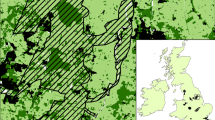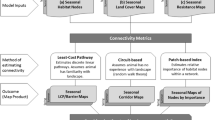Abstract
Many organisms persist in fragmented habitat where movement between patches is essential for long-term demographic and genetic stability. In the absence of direct observation of movement, connectivity or isolation metrics are useful to characterize potential patch-level connectivity. However, multiple metrics exist at varying levels of complexity, and empirical data on species distribution are rarely used to compare performance of metrics. We compared 12 connectivity metrics of varying degrees of complexity to determine which metric best predicts the distribution of prairie dog colonies along an urban gradient of 385 isolated habitat patches in Denver, Colorado, USA. We found that a modified version of the incidence function model including area-weighting of patches and a cost-weighted distance surface best predicted occupancy, where we assumed roads were fairly impermeable to movement, and low-lying drainages provided dispersal corridors. We also found this result to be robust to a range of cost weight parameters. Our results suggest that metrics should incorporate both patch area and the composition of the surrounding matrix. These results provide guidance for improved landscape habitat modeling in fragmented landscapes and can help identify target habitat for conservation and management of prairie dogs in urban systems.


Similar content being viewed by others
References
Akaike H (1973) Information theory as an extension of the maximum likelihood principle. In: Petrov BN, Csaki F (eds) Second international symposium on information theory. Akademiai Kiado, Budapest
Adriaensen F, Chardon JP, De Blust G, Swinnen E, Villalba S, Gulinck H, Matthysen E (2003) The application of “least-cost” modeling as a functional landscape model. Landsc Urban Plan 64:233–247. doi:10.1016/S0169-2046(02)00242-6
Bender DJ, Tischendorf L, Fahrig L (2003) Using patch isolation metrics to predict animal movement in binary landscapes. Landscape Ecol 18:17–39. doi:10.1023/A:1022937226820
Bolger DT, Alberts AC, Sauvajot RM, Potenza P, McCalvin C, Tran D, Mazzoni S, Soulé ME (1997) Response of rodents to habitat fragmentation in coastal southern California. Ecol Appl 7:552–563. doi:10.1890/1051-0761(1997)007[0552:RORTHF]2.0.CO;2
Bolitzer B, Netusil NR (2000) The impact of open spaces on property values in Portland, Oregon. J Environ Manage 59:185–193. doi:10.1006/jema.2000.0351
Brown JH, Gupta VK, Li B, Milne BT, Restrep C, West GB (2002) The fractal nature of nature: power laws, ecological complexity and biodiversity. Philos Trans R Soc Lond B Biol Sci 357:619–626. doi:10.1098/rstb.2001.0993
Burnham KP, Anderson DR (2002) Model selection and multimodel inference: a practical information-theoretic approach, 2nd edn. Springer-Verlag, NY
Calabrese JM, Fagan WF (2004) A comparison-shopper’s guide to connectivity metrics. Front Ecol Environ 2:529–536
Collinge SK, Johnson WC, Ray C, Matchett R, Grensten J, Cully JF Jr, Gage KL, Kosoy MY, Loye JE, Martin AP (2005) Landscape structure and plague occurrence in black-tailed prairie dogs on grasslands of the western USA. Landscape Ecol 20:941–955. doi:10.1007/s10980-005-4617-5
Crooks KR (2002) Relative sensitivities of mammalian carnivores to habitat fragmentation. Conserv Biol 16:1–15. doi:10.1046/j.1523-1739.2002.00386.x
Crooks KR, Sanjayan M (eds) (2006) Connectivity conservation. Cambridge University Press, Cambridge
Crooks KR, Suarez AV, Bolger DT (2004) Avian assemblages along a gradient of urbanization in a highly fragmented landscape. Biol Conserv 115:451–462. doi:10.1016/S0006-3207(03)00162-9
DeStefano S, DeGraff RM (2003) Exploring the ecology of suburban wildlife. Front Ecol Environ 1:95–101
Estrada A (1993) Patterns of frugivore species richness and abundance in forest islands and in agricultural habitats at Los Tuxtlas, Mexico. Vegetatio 107:245–257
Fagan WF, Calabrese JM (2006) Quantifying connectivity: balancing metric performance with data requirements. In: Crooks KR, Sanjayan M (eds) Connectivity conservation. Cambridge University Press, Cambridge
Ferreras P (2001) Landscape structure and asymmetrical inter-patch connectivity in a metapopulation of the endangered Iberian lynx. Biol Conserv 100:125–136. doi:10.1016/S0006-3207(00)00213-5
Forrest S (2005) Getting the story right: a response to Vermeire and colleagues. Bioscience 55:526–530. doi:10.1641/0006-3568(2005)055[0526:GTSRAR]2.0.CO;2
Garrett MG, Franklin WL (1988) Behavioral ecology of dispersal in the black-tailed prairie dog. J Mammal 69:236–250. doi:10.2307/1381375
Garrod GD, Willis KG (1995) Valuing the benefits of the South downs environmentally sensitive area. J Agric Econ 46:160–173
Goodwin BJ (2003) Is landscape connectivity a dependent or an independent variable? Landscape Ecol 18:687–699. doi:10.1023/B:LAND.0000004184.03500.a8
Hanski I (1994) A practical model of metapopulation dynamics. J Anim Ecol 63:151–162. doi:10.2307/5591
Hanski I (1996) Metapopulation dynamics: from concepts and observations to predictive models. In: Hanski I, Gilpin ME (eds) Metapopulation biology. Academic Press, San Diego
Hanski I (1998) Metapopulation dynamics. Nature 396:41–49. doi:10.1038/23876
Hanski I, Gaggiotti OE (eds) (2004) Ecology, genetics, and evolution of metapopulations. Elsevier Academic Press, San Diego
Hoogland JL (1995) The black-tailed prairie dog: social life of a burrowing mammal. University of Chicago Press, Illinois
Johnson WC, Collinge SK (2004) Landscape effects on black-tailed prairie dog colonies. Biol Conserv 115:487–497. doi:10.1016/S0006-3207(03)00165-4
Jordan F, Baldi A, Orci KM, Racz I, Varga Z (2003) Characterizing the importance of habitat patches and corridors in maintaining the landscape connectivity of a Pholidoptera transsylvanica (Orthoptera) metapopulation. Landscape Ecol 18:83–92. doi:10.1023/A:1022958003528
Kerkhoff AJ, Milne BT, Maehr DS (2000) Toward a panther-centric view of the forests of South Florida. Conserv Ecol 4(1): 1. [online] URL: http://www.consecol.org/vol4/iss1/art1/
Knaapen JP, Scheffer M, Harms B (1992) Estimating habitat isolation in landscape planning. Landsc Urban Plan 23:1–16. doi:10.1016/0169-2046(92)90060-D
Kotliar NB (2000) Application of the new keystone-species concept to prairie dogs: how well does it work? Conserv Biol 14:1715–1721. doi:10.1046/j.1523-1739.2000.98384.x
Kotliar NB, Baker BW, Whicker AD (1999) A critical review of assumptions about the prairie dog as a keystone species. Environ Manage 24:177–192. doi:10.1007/s002679900225
Krebs CJ (1989) Ecological methodology. Harper, New York
Lomolino MV, Smith GA (2001) Dynamic biogeography of prairie dog (Cynomys ludovicianus) towns near the edge of their range. J Mammal 82:937–945. doi:10.1644/1545-1542(2001)082<0937:DBOPDC>2.0.CO;2
Lomolino MV, Smith GA (2003) Prairie dog towns as islands: applications of island biogeography and landscape ecology for conserving nonvolant terrestrial vertebrates. Glob Ecol Biogeogr 12:275–286. doi:10.1046/j.1466-822X.2003.00041.x
Lomolino MV, Smith GA, Vidal V (2003) Long-term persistence of prairie dog towns: insights for designing networks of prairie reserves. Biol Conserv 115:111–120. doi:10.1016/S0006-3207(03)00100-9
MacArthur RH, Wilson EO (1967) The theory of island biogeography. Princeton University Press, Princeton
Magle SB (2003) Black-tailed prairie dog (Cynomys ludovicianus) response to human intrusion and urban development in the Colorado front range. Thesis, University of Wisconsin, Madison
Magle SB (2007) The persistence of prairie dogs within urban habitat islands in the Colorado Front Range. Ph.D. Dissertation, Colorado State University
Magle SB (2008) Observations on body mass of prairie dogs in urban habitat. West N Am Nat 68:113–118. doi:10.3398/1527-0904(2008)68[113:OOBMOP]2.0.CO;2
Magle SB, Crooks KR (2008) Interactions between black-tailed prairie dogs (Cymomys ludovicianus) and vegetation in habitat fragmented by urbanization. J Arid Environ 72:238–246. doi:10.1016/j.jaridenv.2007.06.003
Magle SB, Crooks KR (in preparation) Investigating the distribution of prairie dogs in an urban landscape
Magle SB, Zhu J, Crooks KR (2005) Behavioral responses to repeated human intrusion by black-tailed prairie dogs (Cynomys ludovicianus). J Mammal 86:524–530. doi:10.1644/1545-1542(2005)86[524:BRTRHI]2.0.CO;2
Magle SB, McClintock BT, Tripp DW, White GC, Antolin MF, Crooks KR (2007) Mark-resight methodology for estimating population densities of prairie dogs. J Wildl Manage 21:2067–2073. doi:10.2193/2006-138
Miller B, Ceballos G, Reading R (1994) The prairie dog and biotic diversity. Conserv Biol 8:677–681. doi:10.1046/j.1523-1739.1994.08030677.x
Miller B, Reading R, Hoogland J, Clark T, Ceballos G, List R, Forrest S, Hanebury L, Manzano P, Pacheco J, Uresk D (2000) The role of prairie dogs as a keystone species: response to Stapp. Conserv Biol 14:318–321. doi:10.1046/j.1523-1739.2000.99201.x
Moilanen A, Hanski I (2001) On the use of connectivity measures in spatial ecology. Oikos 95:147–151. doi:10.1034/j.1600-0706.2001.950116.x
Moilanen A, Hanski I (2006) Connectivity and metapopulation dynamics in highly fragmented landscapes. In: Crooks KR, Sanjayan M (eds) Connectivity conservation. Cambridge University Press, Cambridge
Moilanen A, Nieminen M (2002) Simple connectivity measures in spatial ecology. Ecology 83:1131–1145
Murphy HT, Lovett-Doust J (2004) Context and connectivity in plant metapopulations and landscape mosaics: does the matrix matter? Oikos 105:3–14. doi:10.1111/j.0030-1299.2004.12754.x
Ricketts TH (2001) The matrix matters: effective isolation in fragmented landscapes. Am Nat 158:87–99. doi:10.1086/320863
Roach JL, Van Horne B, Stapp P, Antolin MF (2001) Genetic structure of a black-tailed prairie dog metapopulation. J Mammal 82:946–959. doi :10.1644/1545-1542(2001)082<0946:GSOAMO>2.0.CO;2
Saaty TL (1980) The analytic hierarchy process. McGraw-Hill, New York
Saaty TL (1994) Fundamentals of decision making and priority theory with the analytic Hierarchy process. RWS Publications, Pittsburgh
Samson FB, Knopf FL (1994) Prairie conservation in North America. Bioscience 44:418–421. doi:10.2307/1312365
Samson FB, Knopf FL (eds) (1996) Prairie conservation: preserving North America’s most endangered ecosystem. Island Press, Washington
Sapoval B, Baldassarri A, Gabrielli A (2004) Self-stabilised fractality of sea-coasts through damped erosion. Phys Rev Lett 99:098501–098511. doi:10.1103/PhysRevLett.93.098501
Saura S, Pascual-Hortal L (2007) A new habitat availability index to integrate connectivity in landscape conservation planning: comparison with existing indices and application to a case study. Landsc Urban Plan 83:91–103. doi:10.1016/j.landurbplan.2007.03.005
Savard JL, Clergeau P, Mennechez G (2000) Biodiversity concepts and urban ecosystems. Landsc Urban Plan 48:131–142. doi:10.1016/S0169-2046(00)00037-2
Smith KV (1993) Nonmarket valuation of environmental resources: an interpretive appraisal. Land Econ 69:1–26. doi:10.2307/3146275
Snäll T, O’Hara RB, Ray C, Collinge SK (2008) Climate-driven spatial dynamics of plague among prairie dog colonies. Am Nat 171:238–248. doi:10.1086/525051
Soulé ME, Estes JA, Berger J, Martinez del Rio C (2003) Ecological effectiveness: conservation goals for interactive species. Conserv Biol 17:1238–1250. doi:10.1046/j.1523-1739.2003.01599.x
Soulé ME, Estes JA, Miller B, Honnold DL (2005) Strongly interacting species: conservation policy, management, and ethics. Bioscience 55:168–176. doi:10.1641/0006-3568(2005)055[0168:SISCPM]2.0.CO;2
Stouffer PC, Bierregaard RO (1995) Effects of forest fragmentation on understory hummingbirds in Amazonian Brazil. Bioscience 42:859–866
Theobald DM (2006) Exploring the functional connectivity of landscapes using landscape networks. In: Crooks KR, Sanjayan M (eds) Connectivity conservation. Cambridge University Press, Cambridge
Theobald DM (2007) LCaP v1.0: landscape connectivity and pattern tools for ArcGIS. Colorado State University, Fort Collins
Theobald DM, Peterson N, Romme W (2004) The Colorado vegetation model: using national land cover data and ancillary spatial data to produce a high resolution, fine-classification map of Colorado. vol 8, Unpublished report, Natural Resource Ecology Lab, Colorado State University. 4 Feb
Theobald DM, Norman JB, Sherburne MR (2006) FunConn v1 user’s manual: ArcGIS tools for functional connectivity modeling. Natural resource ecology Lab. Colorado State University, Fort Collins
Tischendorf L, Fahrig L (2000) On the usage and measurement of landscape connectivity. Oikos 90:7–19. doi:10.1034/j.1600-0706.2000.900102.x
Tischendorf L, Fahrig L (2001) On the use of connectivity measure in spatial ecology. A reply. Oikos 95:152–155. doi:10.1034/j.1600-0706.2001.950117.x
Tischendorf L, Bender DJ, Fahrig L (2003) Evaluation of patch isolation metrics in mosaic landscapes for specialist vs. generalist dispersers. Landscape Ecol 18:41–50. doi:10.1023/A:1022908109982
Truett JC, Dullam JALD, Matchett MR, Owens E, Seery D (2001) Translocating prairie dogs: a review. Wildl Soc Bull 29:863–872
Turner IM, Corlett RT (1996) The conservation value of small, isolated fragments of lowland tropical rain forest. Trends Ecol Evol 11:330–333. doi:10.1016/0169-5347(96)10046-X
Urban DL, Keitt TH (2001) Landscape connectedness: a graph theoretic perspective. Ecology 82:1205–1218
Wiens JA, Stenseth NC, Van Horne B, Ims RA (1993) Ecological mechanisms and landscape ecology. Oikos 66:369–380. doi:10.2307/3544931
Wilcove DS, Rothstein D, Dubow J, Phillips A, Losos E (1998) Quantifying threats to imperiled species in the United States. Bioscience 48:607–615. doi:10.2307/1313420
Wilcox BA, Murphy DD (1985) Conservation strategy: the effects of fragmentation on extinction. Am Nat 125:879–887. doi:10.1086/284386
Acknowledgments
We thank J. Norman for assistance with computing the GIS-based landscape metrics, L. Berkley and E. Lee for help gathering data, to two anonymous reviwers. Funding was provided by a National Science Foundation Graduate Research Fellowship, a University of Wisconsin Graduate Fellowship, the Denver Zoological Foundation, the Milwaukee Zoological Foundation, the Rocky Mountain Goats Foundation, Sigma Xi, Prairie Biotic Research, and the Humane Society of the United States. M. Antolin, J. Detling, and R. Reading provided useful comments on an early draft of this manuscript.
Author information
Authors and Affiliations
Corresponding author
Rights and permissions
About this article
Cite this article
Magle, S.B., Theobald, D.M. & Crooks, K.R. A comparison of metrics predicting landscape connectivity for a highly interactive species along an urban gradient in Colorado, USA. Landscape Ecol 24, 267–280 (2009). https://doi.org/10.1007/s10980-008-9304-x
Received:
Accepted:
Published:
Issue Date:
DOI: https://doi.org/10.1007/s10980-008-9304-x




